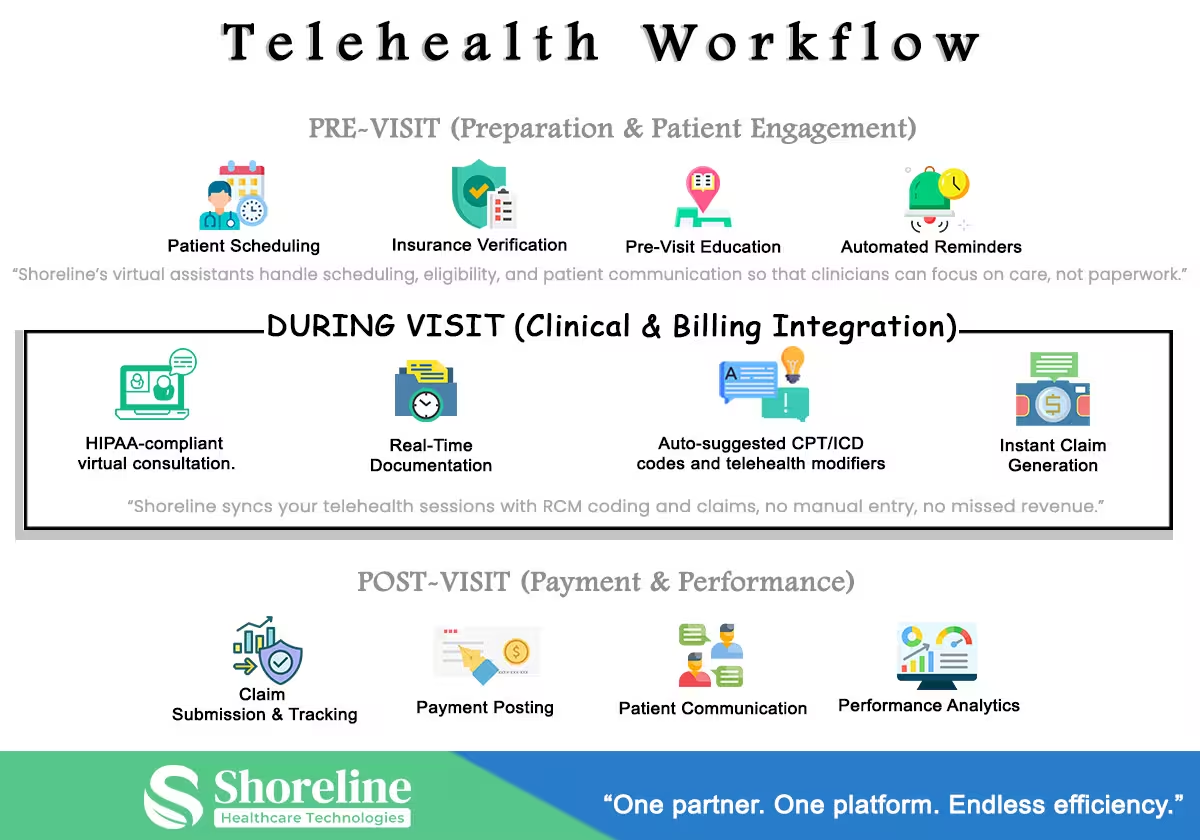Future-Proof Your Telehealth Revenue and Keep Your Practice Profitable
Telehealth is transforming the way of healthcare delivery, bridging the gap between patients and providers making it more convenient, efficient, and accessible. As virtual care continues to expand, setting up the complete telehealth workflow has become essential for healthcare providers for a smoother operation and to increase their revenue. In this blog, let us break down each step of the telehealth workflow, identify the best practices for the successful integration of telehealth services.
What is a Telehealth Workflow?
A telehealth workflow is a structured, patient-centered process designed to deliver efficient, compliant and profitable care which involves sequence of steps and processes for delivering remote care to patient. It comprises everything from patient appointment scheduling to the post-visit follow-up and billing.
Why does telehealth workflow act as a Backbone for Virtual Care?
It provides the necessary framework needed to deliver remote care making it a seamless, efficient, and effective experience for both patients and providers. A well-structured telehealth workflow acts as the backbone for the success of any virtual care program. Without which the virtual care becomes fragmented, leading to operational inefficiencies, frustrated users, and compromised patient outcomes.
Laying the Foundation for a Successful Telehealth Program
Let us look into some of the essential general considerations that serve as the foundation for the entire telehealth program.
Technology Integration: The Heart of Your Workflow
Telehealth platform remains as a fragmented silo without proper integration with the existing Electronic Health Record (EHR). Also, the patient data must be synced between the two systems
We at Shoreline Healthcare Technologies, have designed a dedicated platform that is interoperable with all major EHR systems, ensuring a single source of truth for patient data and a streamlined experience for clinicians.
Documentation and Scheduling
Report the telehealth visits either using the current templates or making a new one for virtual care. Align telehealth appointments with the current schedule and allocate time blocks towards virtual visits or between in-office visits.
Physical and Digital Space: Creating the Right Environment
Providers should be in possession of a private, quiet location with proper lighting, professional background, and working internet connection to carry out telehealth visits. Note the new telehealth policy cliff about the geographic limitations on before offering telehealth services.
Patient Education and Awareness: Fueling Adoption
Inform patients that you provide telehealth services through advertising on website, social media, email newsletters, in-office signs. And guide them on using the telehealth platform with step-by-step guide, video tutorial or specialized support phone line.
Reimbursement and Billing: Making it Financially Viable
Reimbursement policies for telehealth keeps changing always. So, it is required to maintain a specific individual or team to be knowledgeable about the recently acquired latest developments in government as well as commercial payers. Continuously integrate relevant telehealth CPT as well as HCPCS codes within the EHR as well as billing platforms. And educate the team about the particular documentations necessary during telehealth billing to prevent denial of claims and ensure compliance.
We Shoreline Healthcare Technologies have a strong module of billing and coding that is always upgraded to the current telehealth policies for maximum reimbursement.
Defining the workflow phases
Phase 1: The Pre-Visit-Setting the Stage for a Seamless Encounter
This phase emphasis on identifying the eligible patients, educating them, and preparing the systems for the day of the visit to create a professional, efficient, and engaging virtual encounter.
- Identify and define the criteria for telehealth-eligible patients.
- Manage data sharing across providers securely.
- Educate patients on how to use telehealth platforms and what to expect.
- Assign responsibility to staff for patient guidance.
- Establish consistent appointment reminders and scheduling methods.
- Designate contact points for technical or procedural questions.
- Verify the eligibility and check for pre-authorizations before visits.

Phase 2: The Day of the Visit-Delivering an Exceptional Virtual Care Experience
This phase ensures smooth execution of virtual visits.
- Appoint a medical assistant or nurse to join the call first to collect vital information, review medications, and get the patient set up for their visit with the provider.
- Obtain an electronic consent forms that are a convenient and secure.
- Use a platform that allows charting and documenting saving time and improving accuracy.
- Automate coding and modifier use with latest billing platforms.
Phase 3: The Post-Visit Care Continuity
A well-defined post-visit workflow is essential for ensuring continuity of care and closing the loop on the patient encounter.
- Document all the treatment care plans, order prescriptions or lab tests.
- Schedule follow-up visits and determine the need for in-person care.
- Conduct feedback surveys to assess the patient experience.
- Communicate regarding the follow-up visits clearly.
- Collect co-payments and manage the claim submission processes.
- Track and resolve rejected claims.
- Maintain transparency with insurers and patients.
The Shoreline Advantage: Intelligent RCM Meets Human Expertise
Technology That Thinks
We at Shoreline Healthcare Technologies uses automation platform to eliminate repetitive tasks. From eligibility checks to claim follow-ups, our smart algorithms identify issues before they are submitted.
People Who Care
Our team of certified RCM professionals ensures quality, accuracy, and compliance.
Security and Compliance
We at Shoreline Healthcare Technologies follows strict HIPAA-compliance and use the strictest data security protocols. With blockchain technology we protect Patient data by encrypting them and making it accessible only to authorized personnel.
Actionable Insights
Through our advanced analytics and real-time dashboards, providers can monitor KPIs such as denial rate, collection ratio, average days in AR, and telehealth utilization trends helping them to make smarter financial decisions.
FAQs
Q1. How will a successful telehealth workflow enhance revenue cycle management (RCM)?
+An efficient telehealth workflow can automate claim creation, coding, and tracking of payments. And minimizes administrative overhead, denials and quickens the follow of cash to ensure a consistent revenue stream for healthcare practice.
Q2. How do virtual assistants facilitate telehealth billing?
+Shoreline virtual assistants facilitate the administrative functions such as schedule making, verification of insurance, patient reminder minimizing no-shows, and assures efficient billing cycles.
Q3. How can providers try Shoreline Healthcare Technologies?
+Providers can sign up for a free 15-day trial to experience Shoreline’s complete RCM suite covering appointment scheduling, billing, payment collection, and patient engagement tools along with audits that are designed to optimize the revenue cycle.
Q4. Is ShorelineMB the same as Shoreline Healthcare Technologies?
+Yes, ShorelineMB.com is the official website of Shoreline Healthcare Technologies, a leading provider of medical billing and RCM services.

















Contact Shoreline Healthcare Technologies for a free 15 days trial of our complete RCM Suite.